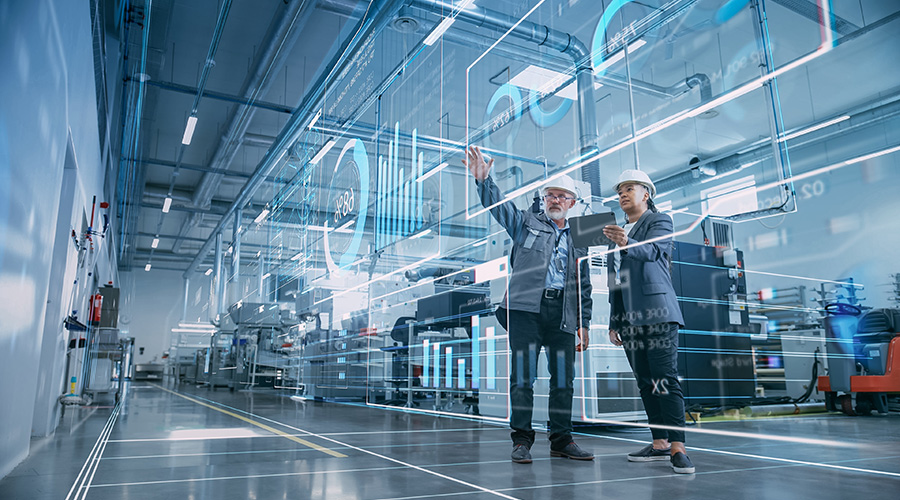How AI and Smart Systems are Creating a New Era for Facility Managers

Employee well-being is a top priority in modern workplaces, and smart building systems, including AI-integrated IoT devices, are revolutionizing how facility managers optimize indoor environmental quality (IEQ), operational efficiencies, and costs. These technologies offer significant benefits in valuation, tenant retention, and market competitiveness.
4 Economic Benefits of Sensor Technology
- Energy Savings — Sensor technology optimizes lighting and HVAC systems based on real-time occupancy, reducing energy consumption and operational costs. In commercial office buildings, landlords can leverage this technology to manage common areas and amenity spaces, further scaling these savings.
- Better Real Estate Utilization — Sensors offer detailed insights into space utilization, helping companies optimize layouts, reduce leasing costs, and enhance productivity. By identifying underutilized areas, facility managers can reallocate spaces for better use, ensuring workspaces are efficient and tailored to employee needs.
- Increased Rental Income Through Digital Infrastructure — Advanced sensor technologies enable landlords to offer modern digital infrastructure, attracting premium tenants and increasing rental income. These smart systems create connected workplaces that are highly desirable, serving as a valuable selling point for brokers.
- Enhanced Branding — Leveraging sensor insights to improve employee well-being demonstrates a company’s commitment to innovation, sustainability, and employee care. This can enhance the company’s brand image, making it more attractive to potential employees, clients, and partners, ultimately boosting market value.
4 Ways Building Controls Promote Workplace Wellness
AI-driven systems monitor and optimize key environmental factors like air quality, lighting, climate, and noise, which are crucial to employee wellness:
- Air Quality — Consistent air quality monitoring is essential for a healthy indoor environment. AI-enabled HVAC systems maintain optimal air quality by introducing fresh air circulation and deploying purifiers in stagnant areas, reducing the risk of cognitive decline and disease transmission.
- Lighting Conditions — Smart lighting systems tailor conditions to meet diverse needs, reducing eye strain and improving focus. By maintaining lighting levels below 4000 Kelvin and offering adjustable options, these systems create a work environment conducive to productivity.
- Climate Controls — Optimizing heating and cooling systems not only enhances employee comfort but also improves energy efficiency. AI-driven HVAC systems ensure consistent and comfortable temperatures, promoting health and satisfaction among employees.
- Ambient Noise — Productivity peaks when ambient noise levels are between 60 to 80 decibels. IoT-enabled noise sensors help maintain these optimal levels, fostering a conducive work environment.
Rethinking Space Utilization and Advocacy for Improvements
AI-driven insights into space utilization empower facility managers to make informed decisions about optimizing desk and room bookings, enhancing collaboration zones, and improving overall workplace efficiency. By analyzing heat maps and occupancy data, managers can identify underutilized areas and repurpose them for better use, such as creating collaboration or wellness zones.
These insights also enable building managers to advocate for critical improvements that enhance both tenant and shared environments. Understanding how spaces perform and their impact on inhabitant comfort and satisfaction is crucial for tenant retention and market competitiveness—factors that are increasingly important in today’s commercial real estate landscape.
Additionally, spatial utilization data supports energy conservation and sustainability efforts. By monitoring lighting and appliance usage, AI-enabled IoT technologies can proactively shut off systems when not in use, reducing operating costs and aligning with ESG goals.
Preparing for the Rise of Autonomous Buildings
The next frontier in smart building technology is the development of autonomous buildings, which use machine learning – rather than set-points or programmed thresholds – to make real-time decisions without human intervention. By continuously analyzing data from sensors and other IoT devices, autonomous buildings can optimize energy use, adjust environmental controls, and even perform maintenance tasks independently.
For facility managers, this means a shift from managing individual systems to overseeing integrated, self-regulating ecosystems. The implications are vast: reduced need for manual intervention, enhanced operational efficiency, and the ability to focus on strategic decision-making rather than day-to-day management. As autonomous buildings become more prevalent, they represent a significant evolution in how facilities are managed, driving even greater sustainability, cost savings, and occupant satisfaction.
AI and smart systems are transforming facility management by enhancing economic benefits, employee wellness, and space utilization. These technologies are essential for creating healthier, more sustainable work environments, marking a fundamental shift in how we approach the workplace of the future. Embracing AI-driven solutions is key to thriving in today’s competitive landscape.
By Erin McDannald, Contributing Writer
Erin McDannald is CEO of Lighting Environments and its sister companies Elevated and Environments. She has been a dynamic force in technology and design for over two decades, championing growth, innovation, and enhancement of the human experience at every step.
The post "How AI and Smart Systems are Creating a New Era for Facility Managers" appeared first on Building Operating & Management

